Light therapy stops your joint pain by working at multiple levels in your body. It penetrates your tissues using specific red and near-infrared wavelengths that boost your cells' energy production through ATP. You'll experience relief as the light triggers increased blood flow, delivering oxygen and nutrients to damaged areas while reducing inflammation. The therapy blocks pain signals in your nerves and stimulates natural pain-fighting compounds like endorphins. It also helps repair damaged tissue and promotes long-term healing through improved cellular function. Understanding these healing mechanisms can help you maximize the benefits of this powerful treatment approach.
Light Therapy Science Basics
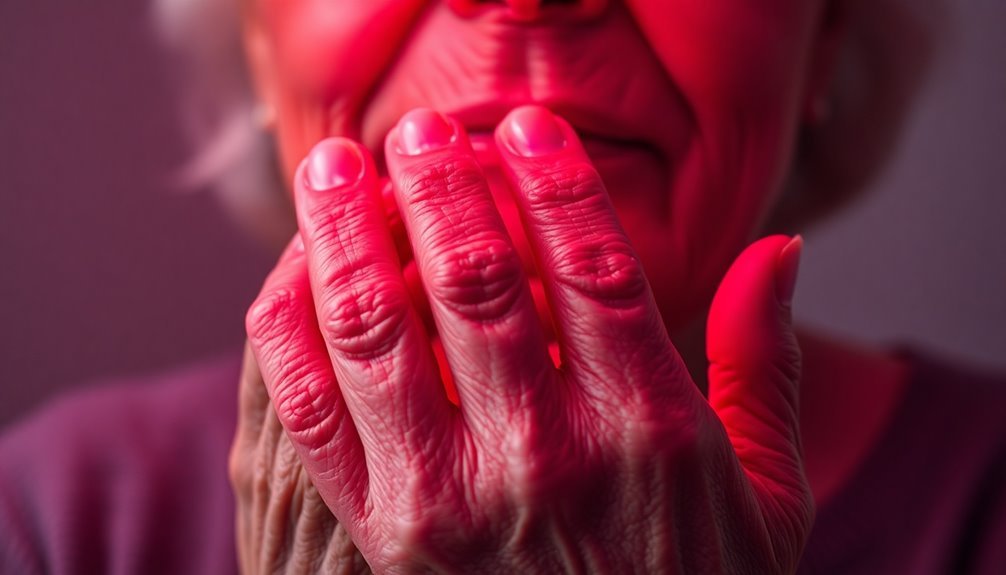
Understanding light therapy begins with its fundamental mechanism: controlled exposure to specific wavelengths of light to trigger healing responses in the body.
When you're receiving light therapy, specific wavelengths penetrate your tissues at varying depths, with near-infrared light reaching deeper structures like joints and muscles. POLY systems effectively deliver these wavelengths through FDA-cleared devices for safe treatment.
The science behind light therapy's effectiveness lies in its interaction with your cells' mitochondria – the powerhouses that produce energy. When light hits these cellular structures, it stimulates increased ATP production, which provides more energy for healing and repair.
This process also triggers vasodilation, improving blood flow to the treated area and enhancing the delivery of oxygen and nutrients.
Different wavelengths serve distinct purposes in joint pain treatment. Red light therapy (600-700 nm) works on surface tissues, while near-infrared light (700-860 nm) penetrates deeper to reach joint structures.
The treatment follows a biphasic dose-response pattern, meaning there's a beneficial amount of exposure – too little won't be effective, and too much could be counterproductive.
For conditions like knee joint pain, targeting specific areas around the joint, such as both sides of the patella, guarantees the most effective treatment outcome.
Pain Relief Mechanisms
When light therapy targets joint pain, it works through three interconnected mechanisms: cellular repair, inflammation reduction, and pain signal modification.
Your cells respond to light therapy by producing more ATP, which powers the healing process. The light stimulates your mitochondria, boosting energy production and triggering increased collagen synthesis. This cellular rejuvenation helps repair damaged joint tissues while promoting faster healing. The therapy simultaneously increases blood circulation, delivering vital nutrients and oxygen to damaged areas.
Light therapy then tackles inflammation by suppressing pro-inflammatory chemicals and increasing anti-inflammatory cytokines. It reduces prostaglandin E2, a key pain mediator, while stimulating the release of beneficial compounds that calm inflamed tissues.
You'll experience less joint swelling as the therapy decreases inflammatory markers in affected areas.
The treatment also disrupts pain signaling by blocking nociceptive transmission – the way your body communicates pain. It's similar to how TENS units work, but light therapy also increases your body's natural pain-fighting compounds, including endorphins.
The therapy modulates pain receptors and reduces central sensitization, helping break the cycle of chronic pain. Additionally, it promotes neural plasticity, which can lead to long-term pain relief through improved nerve function.
Blood Flow Enhancement
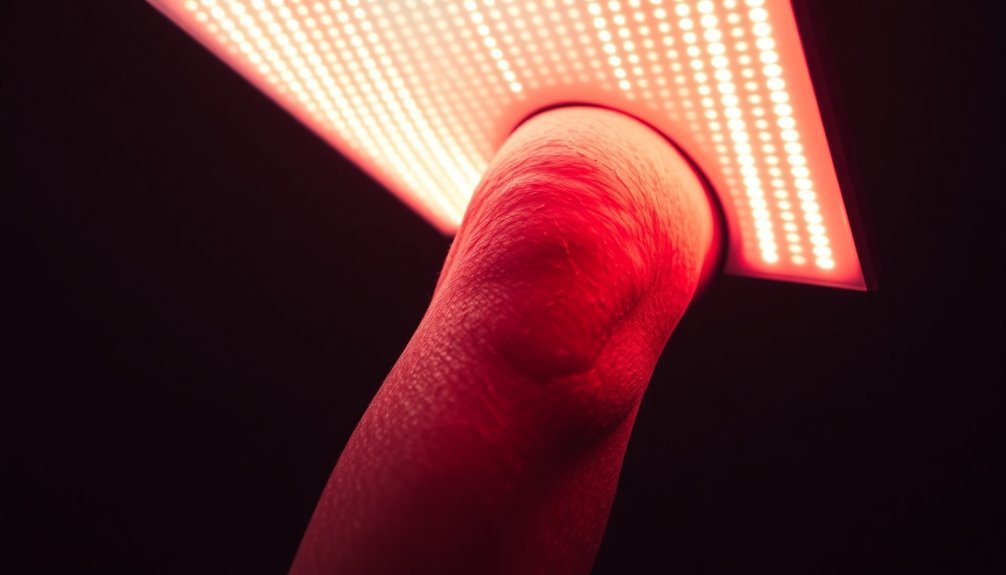
Through targeted light therapy, your blood vessels respond by dilating and increasing circulation to painful joints. As red and near-infrared light penetrates your skin's layers, it creates a gentle heating effect that enhances blood flow to affected areas.
The wavelengths of 660nm and 850nm are optimal for reaching different tissue depths. This improved circulation delivers essential oxygen and nutrients while efficiently removing metabolic waste products that can contribute to joint pain.
You'll experience enhanced healing as the increased blood flow creates an environment that's conducive to recovery. When red light therapy stimulates your vascular systems, it boosts cellular energy production and promotes better joint function.
Clinical trials have shown that this enhanced circulation can reduce pain intensity by more than 50%, particularly in cases of knee osteoarthritis.
What's particularly beneficial is that you can access this treatment easily at home or in clinical settings. The non-invasive nature of red light therapy means you're getting sustained benefits without any risks.
When you maintain regular treatments, you'll continue to experience improved blood flow, reduced inflammation, and better joint mobility. Combined with other therapeutic approaches, red light therapy's circulation-boosting effects can help prevent future joint issues while supporting your current healing process.
Cellular Healing Process
When you undergo light therapy, your cells' mitochondria receive an energy boost that increases ATP production and accelerates healing.
Your enhanced blood flow during treatment delivers essential nutrients and oxygen directly to damaged joint tissues.
You'll experience reduced inflammation as light therapy triggers beneficial molecular responses, promoting tissue repair and long-term pain relief. This process works similarly to how stem cells release growth factors and signaling molecules that stimulate natural healing in damaged joints.
Mitochondrial Energy Production Boost
Light therapy substantially enhances mitochondrial energy production, a crucial factor in cellular healing and pain reduction. When you experience joint pain, it's often linked to dysfunction in your mitochondria, the cellular powerhouses that generate energy. Research shows that chronic pain persists even after inflammation resolves in many rheumatic conditions.
Through photobiomodulation, light therapy directly targets these mitochondria, boosting their ability to produce ATP and improve electron transport.
Your cells need this increased energy production to repair damage and reduce inflammation effectively. When light therapy enhances your mitochondrial function, it triggers a cascade of beneficial effects: your cells begin to proliferate more efficiently, wounds heal faster, and pain signals diminish.
The boost in cellular metabolism helps your body replenish damaged tissue more quickly.
You'll experience relief because enhanced mitochondrial energy production normalizes inflammation and modifies how your nerves transmit pain signals. This process also activates your body's natural opioid receptors, further reducing discomfort.
Improved Blood Flow Benefits
By increasing blood flow throughout your joints and surrounding tissues, red and near-infrared therapy creates ideal conditions for cellular healing. The enhanced circulation delivers essential oxygen and nutrients directly to damaged areas while efficiently removing cellular waste and inflammatory compounds.
You'll experience accelerated healing as the increased blood flow supports your body's natural repair mechanisms and tissue regeneration processes. The therapy's ATP production boost helps energize cells to speed up the healing process.
- Nitric oxide release triggers blood vessel dilation, allowing more oxygen-rich blood to reach painful joints
- Deep-penetrating wavelengths stimulate fibroblasts to produce collagen, strengthening damaged tissues
- LED and laser technology delivers precise, targeted treatment to pain sources without invasive procedures
- Enhanced circulation promotes cellular metabolism and waste removal, reducing inflammation naturally
When light therapy penetrates deep into your joint tissues, it activates multiple healing responses simultaneously. Your cells begin producing more energy, fibroblasts increase collagen synthesis, and keratinocytes multiply to support tissue repair.
This cellular regeneration process, combined with improved blood flow, helps modulate pain signals and stimulate endorphin release. The result is a thorough healing environment that addresses both the symptoms and underlying causes of your joint pain through natural, biological processes.
Anti-inflammatory Molecular Response
Three key molecular responses occur when red and near-infrared light penetrates your joint tissues. First, the therapy triggers a reduction in pro-inflammatory cytokines, particularly TNF-α and IL-1β markers, which are directly responsible for joint pain and swelling. Your body's inflammatory response naturally decreases as these markers drop, leading to noticeable pain relief. The therapy also helps restore proper synovial fluid composition in affected joints.
Second, the light therapy stimulates your cells' mitochondria to produce more ATP, your body's energy currency. This boost in cellular energy accelerates tissue repair and regeneration in your damaged joint areas. As your cells function more efficiently, they're better equipped to heal and maintain healthy joint tissue.
Finally, red light therapy modulates your immune system's response through specific signaling pathways. This modulation helps your body maintain a balanced inflammatory response, preventing excessive inflammation that can damage your joints. You'll experience better joint health as the therapy supports your natural healing processes.
Since these molecular changes work together, you'll notice both immediate and long-term benefits. The therapy's non-invasive nature means you can combine it with other treatments to enhance your recovery from joint pain.
Inflammation Control Methods
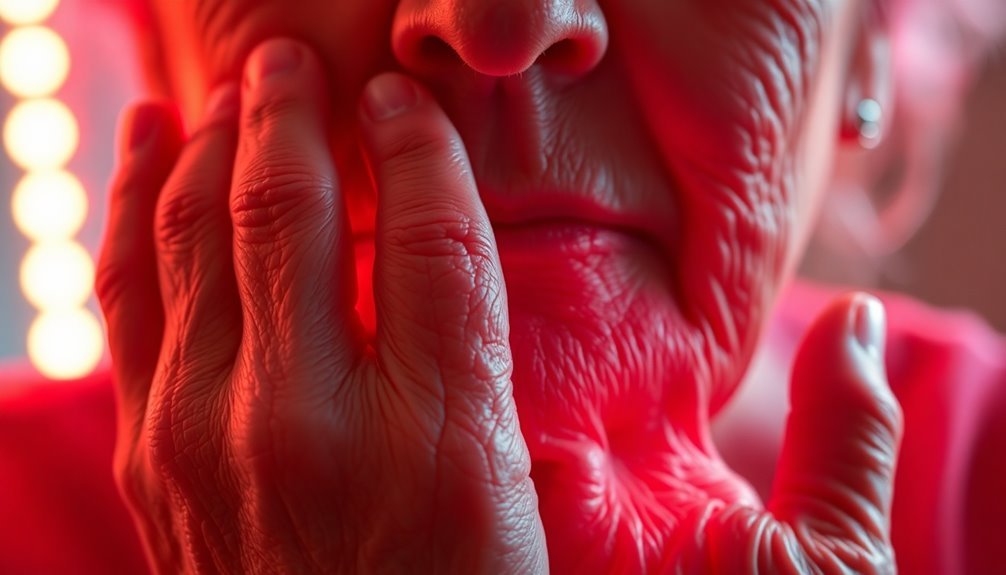
Managing joint inflammation effectively requires a multi-faceted approach that combines both traditional and modern therapeutic methods. You'll find several evidence-based strategies that can markedly reduce joint pain and improve your quality of life.
- Red light therapy stimulates cellular repair and boosts ATP production
- The RICE method (Rest, Ice, Compression, Elevation) provides immediate relief for acute injuries
- Mediterranean diet components naturally fight inflammation
- Photobiomodulation therapy modulates cytokine expression for systemic benefits
When you're dealing with joint inflammation, it's vital to implement both immediate and long-term solutions. Start with traditional methods like the RICE protocol for sudden injuries, while incorporating NSAIDs when needed. Engaging in low-impact aerobic exercise for at least 30 minutes five days a week can significantly improve joint health.
You can enhance these effects by adding red light therapy sessions, which penetrate deep into affected tissues to boost cellular repair and reduce inflammatory markers.
Don't overlook the importance of lifestyle modifications – avoiding pro-inflammatory foods, maintaining regular physical activity, and managing stress levels through meditation or yoga can make a substantial difference.
For the best results, combine therapeutic exercises with light therapy treatments, as this dual approach targets inflammation at both the cellular and systemic levels.
Clinical Results and Studies
Numerous clinical studies have demonstrated the effectiveness of light therapy in treating joint pain and inflammation. Clinical trials show that low-level laser therapy (LLLT) reduces pain by up to 70% compared to placebo treatments, particularly in patients with rheumatoid arthritis and osteoarthritis. You'll find that these results are consistently supported across multiple studies, with significant improvements lasting up to 12 weeks after treatment.
| Condition | Pain Reduction | Treatment Duration |
|---|---|---|
| Rheumatoid Arthritis | 70% | 6-8 weeks |
| Knee Osteoarthritis | Significant | 4-12 weeks |
| Morning Stiffness | Notable | 2-4 weeks |
| Joint Inflammation | Substantial | 3-6 weeks |
Research confirms that LLLT works by stimulating cellular metabolism and reducing inflammation in affected joints. You'll experience improved blood flow and reduced oxidative damage in joint tissues during treatment. The World Association for Laser Therapy's guidelines guarantee optimal therapeutic effects through standardized dosing recommendations. While most studies focus on professional laser treatments, it is crucial to note that results may vary with at-home LED devices. The treatment's safety profile is excellent, with virtually no reported adverse effects.
Healing Time and Duration
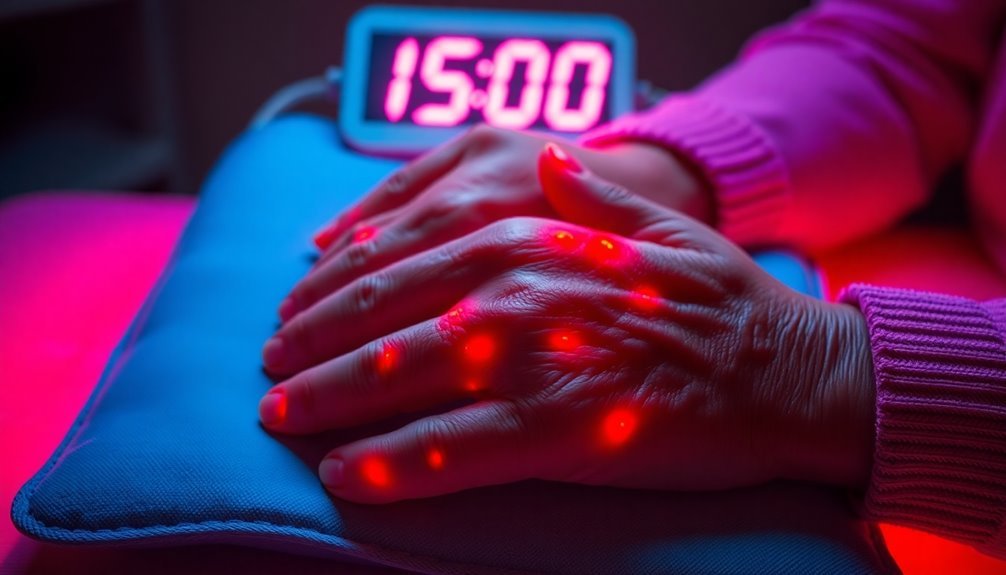
Light therapy's healing timeline varies among individuals, but you can typically expect initial relief from joint pain within 2 to 4 weeks of regular treatment.
You'll notice immediate benefits after each session due to increased blood flow and muscle relaxation, though lasting results require consistent application.
For ideal healing, you'll need 10-20 minute sessions targeting specific joint areas, with treatments scheduled 2-3 times per week at minimum.
- Your age plays a significant role in healing speed, as younger individuals often experience faster cellular repair.
- You'll see faster results with mild to moderate joint pain compared to severe conditions.
- Your commitment to regular sessions directly impacts the effectiveness of the treatment.
- You'll need maintenance sessions even after improvement to prevent pain recurrence.
Long-term healing typically occurs after 3-6 months of consistent use, particularly if you're dealing with chronic conditions like arthritis. While you might experience quick initial relief, the regeneration of damaged tissues and reduction of chronic inflammation takes time.
Once you've achieved significant improvement, you can reduce your session frequency to 1-2 times weekly for maintenance, but don't stop completely – consistency remains key for sustained joint health.
Treatment Techniques and Protocols
To effectively treat joint pain with red light therapy, you'll need to follow specific protocols that maximize its therapeutic benefits. The key components include selecting the right wavelength, treatment duration, and frequency of sessions. You'll typically need 10-20 minute sessions multiple times per week, using devices that emit red and near-infrared light for ideal joint penetration.
For best results, you'll want to position the light device directly over your affected joint, maintaining a consistent distance as recommended by your device manufacturer. You can combine these treatments with other therapies like physical exercise or medication for enhanced outcomes.
| Treatment Aspect | Protocol | Benefits |
|---|---|---|
| Frequency | 3-5 times weekly | Maintains healing momentum |
| Duration | 10-20 minutes | Allows proper tissue penetration |
| Distance | As per device specs | Guarantees optimal light absorption |
| Positioning | Directly over joint | Maximizes therapeutic effect |
During treatment, you'll need to keep the area exposed and clean. While you won't feel heat, the light is penetrating deep into your joint tissues, stimulating cellular repair and reducing inflammation. You can safely perform these treatments at home, making it convenient to maintain a consistent therapy schedule.
Recovery Success Stories

Real-world success stories validate the effectiveness of these treatment protocols. You'll find numerous accounts of patients experiencing significant improvements in their joint pain and mobility after incorporating light therapy into their treatment plans.
Post-surgery patients have reported faster recovery times and enhanced ability to walk, while arthritis sufferers note substantial reductions in stiffness and inflammation.
The combination of red light therapy with PEMF has proven particularly effective for elderly individuals managing arthritis-related challenges. You're likely to see improvements in:
- Reduced leg swelling and increased stability during daily activities
- Enhanced energy levels, allowing longer periods of activity without frequent breaks
- Decreased stiffness in neck, back, and hip joints
- Improved circulation and faster post-exercise recovery
When you commit to regular sessions, you'll typically experience sustained benefits in pain management and joint mobility. The success stories consistently show that light therapy, especially when combined with complementary treatments like cryotherapy, delivers meaningful improvements in quality of life.
These real-world results align with scientific findings on photobiomodulation's ability to stimulate cellular activity and support tissue repair.
Frequently Asked Questions
Can Light Therapy Treatments Interfere With Medications I'm Currently Taking?
Yes, light therapy can interfere with your medications, especially those that increase photosensitivity. You'll need to consult your healthcare provider about potential interactions before starting treatment, as some combinations may cause adverse reactions.
Is Red Light Therapy Safe During Pregnancy or While Breastfeeding?
You can safely use red light therapy during pregnancy and breastfeeding, but don't apply it directly to your stomach area. It's best to focus on other body parts and always consult your healthcare provider first.
How Many Sessions Are Needed Before Seeing Permanent Improvement?
You'll typically need several weeks of consistent sessions to see lasting improvements. While initial benefits may appear within a few sessions, permanent results require ongoing treatment with 2-3 sessions per week for the best possible results.
Does Light Therapy Work Equally Well on All Types of Joint Pain?
No, you'll find light therapy isn't equally effective for all joint pain. While it works well for osteoarthritis and rheumatoid arthritis, its effectiveness varies based on the pain's depth and underlying cause.
Can I Combine Light Therapy With Other Pain Management Treatments?
Yes, you can safely combine light therapy with medications, physical therapy, and alternative treatments. It's often more effective when used alongside other therapies, but always consult your healthcare provider before starting combined treatments.
In Summary
You'll find that light therapy effectively stops joint pain through its ability to boost circulation, reduce inflammation, and trigger cellular repair. When you follow proper treatment protocols, you're likely to experience relief within a few sessions. Whether you're dealing with arthritis, injuries, or chronic pain, research shows that light therapy's natural healing mechanisms can help restore your joint mobility and improve your quality of life.

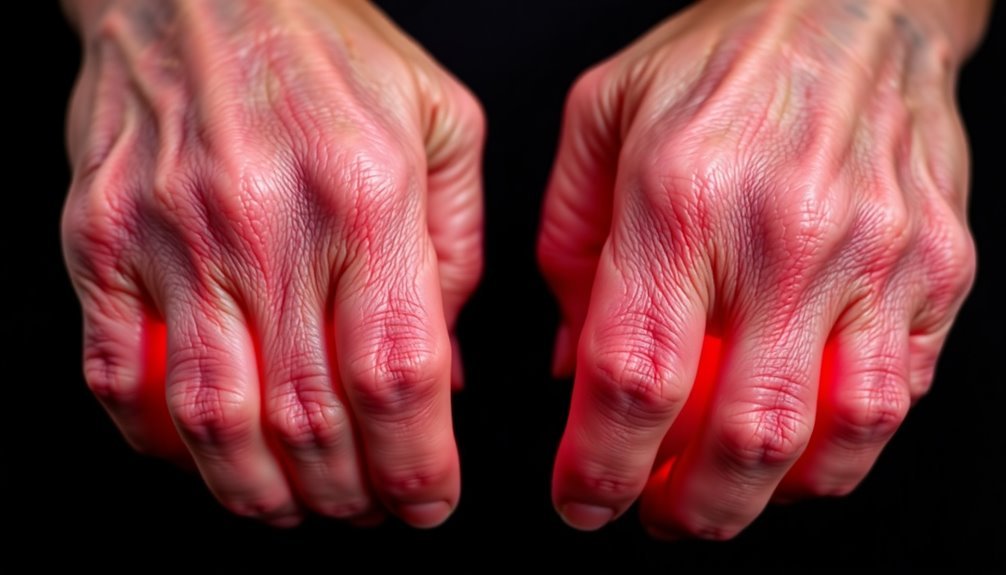



Leave a Reply